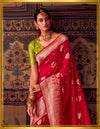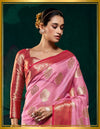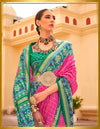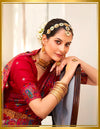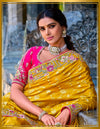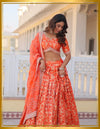World's Costliest Saree | Vivaah Pattu | Real Story, Price
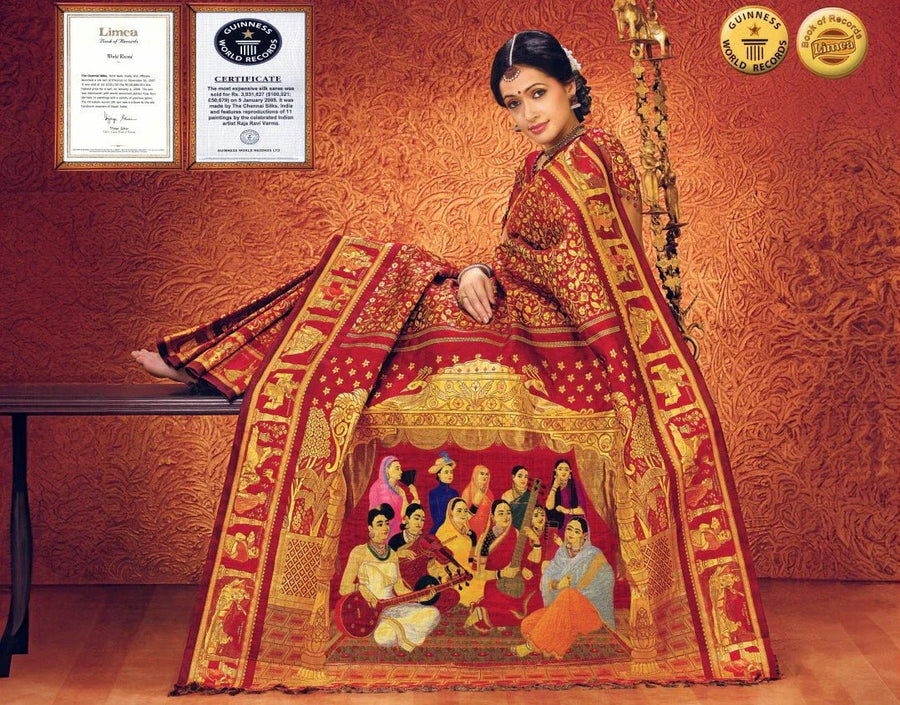
Can a saree cost more than a Mercedes? Not in a film, not on the ramp, but in real life, woven thread by thread. There is a lot of noise on the internet about "the world's most expensive saree." Some of it is fake. Some of it is forgotten. Here is the truth.
The Viral Claim: Nita Ambani’s 40 Crore Saree?
You might have seen headlines claiming that Nita Ambani wore a saree worth 40 crore rupees.
That story is not true.
The actual rumour came from an unverified article stating that she wore a saree worth 40 lakhs, not crores. Even that amount is uncertain, and there is no official confirmation or record. Yet many blogs and Instagram pages continue to circulate this like it is fact.
So let us clear it up: Nita Ambani did not wear the world’s most expensive saree.
World's Costliest Saree: Vivaah Pattu Saree by Chennai Silks

If we are talking about the saree officially acknowledged as the most expensive silk saree in the world, the answer is this:
Vivaah Pattu saree, created by Chennai Silks, sold for Rs. 39,31,627 on 5 January 2008.
This saree holds a Guinness World Record and is a one-of-a-kind tribute to Indian art and textile legacy.
Vivaah Pattu: What Made This Saree So Valuable?
Vivaah Pattu was not just about gold and diamonds. The heart of this saree is Raja Ravi Varma’s paintings. Eleven of them, to be exact.
The central pallu features the iconic Galaxy of Musicians — women in traditional attire, each playing a musical instrument. This scene was handwoven, not printed.

It took:
-
4,760 hours of manual work
-
36 skilled weavers
-
Over 1.5 years to complete
-
Help of CAD software to punch 66,700 design cards and manage 7,440 jacquard hooks
But there is more to it than numbers.
The Power of the Pallu: Ravi Varma’s 'Galaxy of Musicians'

The pallu of the Vivaah Pattu saree is not just art, it is emotion.
Raja Ravi Varma’s painting "Galaxy of Musicians" shows a gathering of Indian women from different states, each dressed in her regional traditional garments and playing a musical instrument native to her culture. If you look at the image, there is a veena player from Kerala, a tabla player from the north, a sarangi from the west, and even instruments like the tanpura, sitar, and dholak.
These women are not courtesans or deities. They are everyday women representing the musical soul of India. From Marathi to Bengali, Tamil to Punjabi. The entire canvas comes alive like a cultural map told through rhythm and expression.
Weaving that image onto a silk saree, thread by thread, using 16 colours and 64 shades, was not a decorative move. It was a revival. A documentation. A way to make a saree speak.
It makes us feel proud that the timeless Indian saree found its place in the Guinness Book, not just for diamonds or rubies, but because it carried a painting that told a story.

When you look at the saree, you are not looking at a luxury product. You are looking at Kancheepuram silk carrying Kerala’s royal artist, Tamil Nadu’s handloom magic, and the music of the entire subcontinent—all stitched into one.
Most expensive saree - Materials Used in Vivaah Pattu
This saree is not just wearable—it is precious. Here is what is inside:
-
Gold: 59.7 grams
-
Diamond: 3.913 carats
-
Platinum: 120 mg
-
Silver: 5 grams
-
Ruby: 2.985 carats
-
Emerald: 55 cent
-
Yellow sapphire: 3 cent
-
Sapphire: 5 carats
-
Cat eye: 14 cent
-
Topaz: 10 cent
-
Pearl: 2 grams
-
Coral: 400 mg
Weight: Around 8 kilograms
The Vivaah Pattu Kanjivaram saree was made in Kancheepuram using the double warp technique. The brocade alone features 64 colour shades and 10 unique designs.
Who Bought It?
-
The first buyer: A Bangalore-based businessman, on his 10th wedding anniversary.
-
The second version (cost: ₹40 lakhs) was custom-made in 2009 for a Kuwait-based businessman, who wanted to remain anonymous.
Not Just for Display — It Is Wearable
Despite weighing nearly 8 kg and carrying navratna stones, the vivaah pattu saree can be draped like any bridal silk saree. The Ravi Varma painting on the pallu is not stiff or ornamental—it is woven seamlessly into the fabric.
Even now, the saree is undergoing rejuvenation to preserve its colours and fabric, but the original artistry is intact.
 New Arrivals
New Arrivals
 Saree Weaves
Saree Weaves
 Banarasi Sarees
Banarasi Sarees
 Kanjivaram Sarees
Kanjivaram Sarees
 Paithani Sarees
Paithani Sarees
 Patola Sarees
Patola Sarees
 Organza Sarees
Organza Sarees
 Chikankari Sarees
Chikankari Sarees
 Kashmiri Jamawar Sarees
Kashmiri Jamawar Sarees
 Dola Silk Sarees
Dola Silk Sarees
 Dharmavaram Silk Sarees
Dharmavaram Silk Sarees
 Saree Fabric
Saree Fabric
 Silk Sarees
Silk Sarees
 Soft Silk Sarees
Soft Silk Sarees
 Linen Sarees
Linen Sarees
 Satin Sarees
Satin Sarees
 Digital Printed Sarees
Digital Printed Sarees
 Tissue Silk Sarees
Tissue Silk Sarees
 Occasion
Occasion
 Festive Wear Sarees
Festive Wear Sarees
 Office Wear Sarees
Office Wear Sarees
 Party Wear Sarees
Party Wear Sarees
 Luxe Collection
Luxe Collection
 Wedding Collection
Wedding Collection
 Engagement Sarees
Engagement Sarees
 Haldi Sarees
Haldi Sarees
 Sangeet Sarees
Sangeet Sarees
 Wedding Banarasi Sarees
Wedding Banarasi Sarees
 Wedding Kanjivaram Sarees
Wedding Kanjivaram Sarees
 Wedding Organza Sarees
Wedding Organza Sarees
 Wedding Patola Sarees
Wedding Patola Sarees
 Sarees By Color
Sarees By Color
 Price Range
Price Range
 Designer Silk Sarees
Designer Silk Sarees
 Track Your Order
Track Your Order
